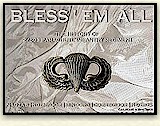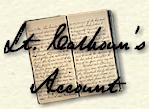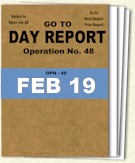

Bill
Bailey |
I am left with trying to reconstruct the plan of that night, the
18th, from memory and what
notes I could find. As best I can recollect, Lt. Browne, S-3 of 2nd Battalion
came to my Command Post in a bombed out building on the Cheney Ravine end of the
"Long Barracks" about 11:00 hours that day and instructed me to take
and hold the two small hills about 300 yards toward Cheney Ravine.
I made a reconnaissance, then divided the company into 2 platoons, since
we were decimated by casualties. I
put Lt. Bill Calhoun in command of the left flank hill attacking force, while I took the right hill attacking force.
We
carried the two hills by about 1400-1500 hours.
As soon as the men dug in, I sent every man but a few back to supply,
with instructions to hurry over and hurry back with all the ammo they could
carry. It was lonesome out
there with a skeleton crew, because in case of a counterattack with much force
we would not have been able to hold it. Fortunately
that did not occur and we were soon back together again with plenty of small
arms ammo, frag and W.P. grenades, and 60 mm mortar rounds.
The
day was waning by then. As we approached the twilight, but not there, we heard
the firing start up on the company's left flank where Al Turinsky's
"D" Company was busy. I
do not recall any order to tie the defence with Turinsky and seem to think that
each company was to set up strong points on the objective assigned and to hold,
since the distance between strong points was so short and the absence of
cover so universal out there that everyone could see everyone else.
We had a good idea where Al Turinsky was and the firing got our attention
so we would not be firing into them.
I'm
not sure when the Banzai attack got going.
Seems to me it was about 2300 hours, when we began hearing them whooping
and hollering down at the ocean shoreline.
This became organized, into
one voice yelling for a few seconds, then
the crowd roaring Banzai! Banzai! Banzai! It
went on for maybe an hour or so and then the fire fight began.
I'm not sure if the firing started with "D" Co. or
"F" Co. but it was soon all along that front.
The Japs were soon very close to us and I never heard so many grenades go
off before, or since. The Nips had
plenty and we had plenty and to this day I feel the hair stand up on the back of
my neck when some child fires a cap pistol near me.
It sounds so much like a grenade cap going off.
It
was well toward noon the next day before the situation was under control in our
area and one could move about without getting shot at.
We learned about ten that Al had been killed and "D" Company
pretty badly mauled. We were happy
when Browne pulled "F" Co. back to the vicinity of the old Post
Exchange-Post Theatre for some rest. I'm
not sure but seem to remember that we counted 135 Japs dead in and around our
position."
The
Japanese made their only sustained effort to recapture Topside. They had held their better trained troops, the marines, in
bombproof shelters in the Grubbs Ravine area and had sent two forces up to take
Topside. The north force struck
"F" Company and the south force struck "D" company.
I think they held their poorer trained troops in defensive positions
since it takes less training to defend than to attack.
We
still had seen no movement from the other half of our company. Bailey's
narrative explains why. They were still having their own problems.
|
|

Edward "Russian"
Porzuczek |
Do you realize everything you threw at the Japs came on top of our hill?
We couldn't put our heads up to check what was going on.
You guys sure fired up a storm.
When
they moved they, too, drew fire.
|
|
|
|
|

Bill Bailey |
Our
situation was now eased from the east, but every time we raised up, we drew LMG
and rifle fire from the trolley car area on our north. The LMG was under one of
the two trolley cars. We had a bazooka with ammunition. The gunner fired several rounds into the car floors, but the
wood was so rotten and soft that the rounds would not detonate. Pfc Bill
McDonald was an excellent marksman with any weapon.
The bazooka gunner had been shaken by the Jap Nambu giving him haircuts
and was ready to let someone else try his weapon. I asked Bill if he could hit the rails under the cars. He did
it on the first try, and to prove it no fluke he was able to hit the rails
several more times until the Nambu was silenced for good. The flying steel tore
the gun up as well as the enemy under both cars.
One
Jap survived and crawled out from under the cars and sat facing us with his legs
crossed. He held both arms extended above his head and would bow toward us. We
could not tell if he was asking to surrender or if he was praying. I apprised
Bailey of the situation. He said that the regiment was desperate for prisoners,
so much so that Col Jones had said that anyone capturing a prisoner would be
given 3 days R & R at the first opportunity and for us to try and take the
man alive.
I
sent a patrol down, relating Colonel Jones's promise as
motivation, for it was difficult under these circumstances to care any more
about an individual, but warned them to shoot if he tried anything. Our
men were wary and knowledgeable enough of the Japs by now to make such a warning
unnecessary, but I did anyhow. As
the patrol neared the Jap, he picked up a hand grenade from his lap and died
immediately.
They
withdrew, unaware that some of the
bodies nearby were not quite dead. George Mikel, our runner, would find this out
later.
|
|

John Bartlett
|
Early that afternoon I was looking down the north side of the hill and saw those
Jap big machine guns in front of the trolley cars.
I asked Bandt to go down and help me get them so they wouldn't be used on
us that night. We took our M1's and
a bandolier of ammo. When we
reached the trolley cars there were 4 Japs in a hole to the left about 25 feet
from the cars. When the guys on top
of the hill saw what was happening several came down to help us. I remember
George Mikel going around the back of those trolley cars when 4 Japs jumped him
and tried to get a grenade down the front of his jacket.
I still laugh when I think of him running around, shouting "They're
alive! Shoot them!" After we
took care of the Japs we took several machine guns and rifles back up the hill.
Bill
Bailey has stated that their force
on Way Hill killed 135 Japs. Our count was about 315. We counted and estimated
about 200 dead enemy in Maggot Valley. We had to use some estimation, because
the Japs had dragged many bodies into craters. We did not remove the bodies to
count them. Two very large craters on Grubbs Road were filled to the top, as
well as several smaller craters. We made this count the next day, 20 Feb. There
70 bodies in between our east defenses and the crater, about 30 down in the
railroad cut, and 15 in the crater adjoining the cut.
|
|

Edward "Russian"
Porzuczek |
"The
day of the banzai attack? It was
the most exciting day I ever had. That
night I was with Bailey on Way Hill . Third squad was on the opposite side of
the hill the Japs attacked. I
happened to have a good position, with a big rock in front of me.
Colonel Jones happened to be inspecting the hill that afternoon. He
stopped in front of my position and noticed no one on the right flank.
I happened to be the nearest to him, and so was Morgan, and he told us to
go to the right flank and protect a little road. Morgan and me crawled out there
on the flank and laid on the flat ground. No
protection. It was pretty dark. While
going to the flank I noticed Ballard and Sedinger in a 500 lb bomb crater.
Soon it got dark. About an
hour later I noticed one, two, three, four, five Japs coming out of a hole in
the mountain. After counting up to
twenty Japs, and more coming, they were about 60 or 70 yards away.
I nudged Morgan. He had seen
them, too. We decided to go to
Ballard's position. I pulled the
pin out of my grenade and started crawling to Ballard's 500 lb crater.
Real, real slow, Morgan behind me whispered "Ballard, Ballard."
Pretty soon I heard Ballard say "Here."
Morgan and me crawled into Ballard's and Sedinger's crater.
I got to the bottom of the crater and Ballard asked
"What
did you see?"
"A
shithouse full of Japs."
"Why
didn't you stay there?"
"Because
they were about to trip on me."
While
I was talking to him, I mean
whispering to him, I was trying to put the pin back in the hole. I must have released it too far.
I heard a pop and so did the others in the hole.
They got out on the top and I was in the bottom of the hole.
I tried also to get out of the hole but where I stood the dirt was soft
and I couldn't get out so I hit the dirt. All
I got was dirt on me. Ballard came back to where I was standing.
"Was
that a Jap grenade?"
"No,
it was mine."
So
after cussing me up he had the pin out of his phosphorus grenade. Remember, I
was on the bottom of the crater with Ballard.
Soon I hear a pop again. Ballard did the same thing I did, released the
grenade too far! After trying to
get out of the crater Ballard and me hit the ground again.
Seddinger
and Morgan were on top again and got out. The
phosphorus lit our hole up like daylight. My rifle butt was on fire.
Ballard's helmet had fire on it. We
climbed to the top of the crater and awaited the Japs to attack or at least to
check out the light. Ballard ate dirt. Porzuczek was shit scared.
After
laying there and shaking like hell nothing happened.
After about a half hour we heard Banzai. They attacked Calhoun's Hill.
But now I realize the Japs knew we were there all the time.
They wanted Hearn I think. I had more exciting days but the two grenades going
off in the same hole with the banzai was my most screwed up and exciting
day."
|
|
Fred
Morgan was killed the afternoon of the 19th, in front of the Ordnance Machine
Shop. |
|

Frank Zurovec |
Russian
and Fred Morgan had crawled up the hill to the crater defended by S/Sgt Carl
Ballard and Pvt Alvin Seddinger. I
shared a position next to Ballard's crater with my assistant gunner, Pfc John
Shannon. We witnessed the grenade episodes.
Our activities for the night consisted pretty much of throwing grenades,
and keeping our heads down.
|
|

John Bartlett |
The
next morning we were under fire from the railroad cut where the tracks ran
through the east side of the hill.  Pasqualle
Rugio was killed at this time. It
was Burl Martin on the mortar team that cleaned out the Jap with mortar fire
going down the ditch. We were no
longer under fire for the rest of the
morning. (This story is given at greater detail in
The
Night of A Thousand Hours.) Pasqualle
Rugio was killed at this time. It
was Burl Martin on the mortar team that cleaned out the Jap with mortar fire
going down the ditch. We were no
longer under fire for the rest of the
morning. (This story is given at greater detail in
The
Night of A Thousand Hours.) |
|

|
Any
joy we felt at surviving the night was lost when disturbing news came in
as movement recommenced
at dawn. "D" company
had been overrun by the Japs during the night. News was sketchy, but they said
casualties were heavy. We did learn
right off that the commanding officer, 1st Lt Joseph A. "Al" Turinsky,
was among those killed. A large force of the enemy had attacked them sometime
after midnight.
Later
we learned that indeed their poor position and lack of time to set-up the best
defense they could have accomplished, was the primary cause of the heavy
casualties. The southern force of the Jap defending force had quietly moved up from
Cheney Ravine's south slope and were among the D Company defenders before their
presence was known. Not only this,
but since D Company was strung out along the ridge, the Japs struck them in the
middle, making contact first with the mortar platoon, under 1st Lt. John L.
Lindgren and then Company
Headquarters, their weakest point.
|
|
"D"
company's poor position had cost them dearly.
At the Army and GHQ level this was a minor incident which may not have
even been known, or if it was, might have been passed
off
as only a dozen men losing their lives.
The 503d was a small and tightly-knit unit, and at platoon level, the life of
every man was vitally important. The combat leaders did all
they could to protect each life, but what might seem an inconsequential mistake
at the general staff level, specifically G-2, had profound and lasting
consequences amongst the men, who feel, even to this day, that the great G-2 blunder led to the loss of these D Company men. each life, but what might seem an inconsequential mistake
at the general staff level, specifically G-2, had profound and lasting
consequences amongst the men, who feel, even to this day, that the great G-2 blunder led to the loss of these D Company men.
Evidently
the North force was to come up Maggot Valley en route to Topside several hours
ahead of the Cheney force. They
were to make a lot of noise and attract a lot of attention. By their numbers and determination they would bull their way
through and some would reach Topside.
Had the entire force succeeded in passing Hearn Magazine, the path to Topside
lay open. This would have put both the headquarters and the high ground in
serious jeopardy, for there were no reserves. With
the troopers on Topside desperately defending
the barracks, the southern force would quietly slip up Cheney Trail, overrun "D" company and storm across Topside finishing us off there.
The Japanese plan had merit,
but faltered when the majority split, with one thrust going over to
attack Way Hill and the other to attack Hearn Magazine from the rear.
|
|
|
� |
|
|
 |
|
|

Corregidor could go from nothing at all to a
million miles an hour within the space of a
few seconds. We were taking a break (notice
that we are not wearing our webbing) when we
heard shooting at the base of Way Hill.
Frank Morgan had looked through into the
covered area, and had been shot at the price
of his curiosity. Mortars, and even a
75mm howitzer firing direct across its iron
sights couldn't finish the Japs off. Cold
steel had to finish the job.

The Ordnance Machine Shop where Fred Morgan was
killed.

The Ordnance
Machine Shop in 2010.
|









